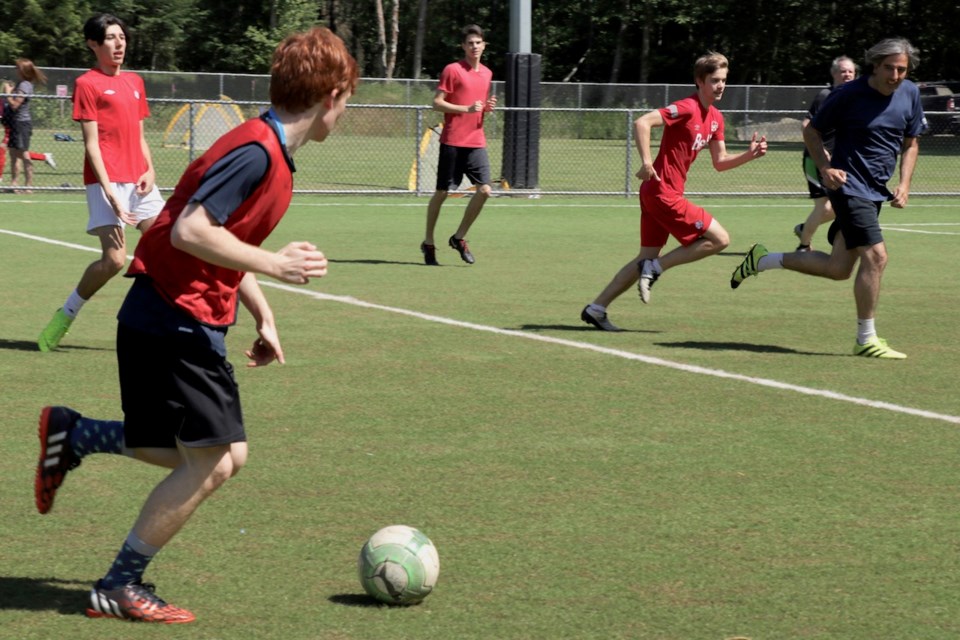The lights at Municipal Hall Monday evening flicked off and on as if a final curtain call for outgoing Bowen Island Arts Council (Hearth) executive director Jacqueline Massey. Massey gave her final annual report presentation to BIM and received (the council equivalent of) thunderous applause. While BC Hydro’s substation issues in Horseshoe Bay kept much of the island in darkness, the first open council meeting of the decade forged ahead.
The following are briefs from the Jan. 13 council meeting.
New decade, new turf: As the artificial turf field at Bowen Island Community School has reached the end of its decade-long life as expected, BIM is looking at replacement options.
Though the football club proposed replacing the current half field with a full-size iteration, that would be a more than $1.5 million project. Council opted to stick with the half field for now. However, the current coconut husk-cork infill is no longer a recommended option for the Southwest Coast region. It breaks down easily, creating an undesirably compact surface, and has required a bi-annual refilling to a cost of $10,000 to $13,000. The three other infill options BIM is considering are crumb rubber, thermoplastic elastomer and ethylene propylene diene monomer infills. The crumb rubber is a recycled material but cannot be used again whereas the two other options are made of raw materials but can be reused in future turf fields. Manager of Recreation and Community Services Shauna Jennings noted in her staff report that while have been concerns raised in the media about the crumb rubber, it remains the industry standard and is used in North Vancouver’s facilities. Jennings said that the crumb rubber is also the cheapest option and has the lowest carbon footprint as it’s reusing old tires. Jennings noted that of concern in selecting materials was the infill controversy that erupted 10 years ago when the field was built.
While councillors generally leaned toward the crumb rubber, they asked for more information as to how much money reusable infills could save in the future. In the meantime, council unanimously agreed to hire R.F. Binnie consultants as the project managers for the field.
While the capital expenses will need to be approved through the budget process, the project is estimated at between $250,000 and $290,000.
The projected completion date in Jennings’ report is Aug. 17, 2020.
Water recap: Interim director of engineering Glen Shkurhan gave his final presentation to open council before the new engineering director starts Jan. 20 (presumably Shkurhan will be involved in a transition period). Shkurhan, a principal with Urban Systems, joined BIM in the midst of last summer’s water troubles on the west side of the island. Last fall, Shkurhan attended meetings with all seven water system local advisory committees (LACs) and Monday brought forward a summarized list of the committees’ resolutions. A common theme among the systems’ comments was the need for improved communication between BIM and the LACs said Shkurhan. Specific recommendations from the LACs included splitting the cost of the Bluewater watermain repairs last July between public works and the water system, budgeting for well monitoring equipment for Bowen Bay, reviewing shelved water system reports, buying a water storage tank for Tunstall Bay and replacing the Eagle Cliff depth gauge. Councillors raised concerns about the amount of staff time and money that would go into these recommendations and council directed staff to create a work plan and budget for the list. Shkurhan noted that this is just the first list of recommendations coming to council about the water systems.
It’s all fine(s): It’s been a year since Bowen got business licenses but so far, BIM’s issued no fines for non-compliance. It has focussed rather on education over the past twelve months. However, council voted to start enforcing the business licence bylaw. After a warning letter, fines start at $25. As of Dec. 15, 357 businesses had applied for licences. A staff report from Daniel Martin, manager of planning and development, estimates that between 10 and 15 businesses with storefronts and approximately 100 email contacts haven’t applied for licences. Mayor Gary Ander said that he was concerned about off-island businesses not applying for licences and encouraged staff to ensure that they’re capturing that base.
Two decades later: Snug Cove House Society received a development variance permit for its Miller Rd. seniors’ housing building. The variance allows the society’s lot coverage to increase from 55 per cent to 65 per cent. As there were some concerns about neighbours’ privacy, council is requiring the society to include a privacy barrier in the design.
Trailing questions: The proposed motorized vehicle trail up Mt. Gardner got some council airtime. Councillors and staff said that they hadn’t had any communications from the province about the project (as the trail would be on Crown lands it’s under provincial jurisdiction). Council directed BIM staff to send a letter to Tom Blackbird of B.C.’s Ministry of Forests, Lands and Natural Resources “expressing concern and requesting information on the proposed project and its status.”



